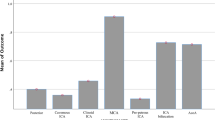Abstract
Recurrent intracranial aneurysms can occur after either surgical clipping or endovascular therapy. In this article, we present a consecutive series of 18 patients who underwent individual treatment for recurrent aneurysms after primary coil embolization or surgical clipping. During an 8-year period between May 1997 and December 2005, 18 patients underwent individual treatment for recurrent aneurysms. Clinical data and imaging studies of the patients were analyzed retrospectively. Out of the 18 patients, 13 had recurrent aneurysms located in the anterior circulation, and 5 had aneurysms of the posterior circulation. Treatment consisted of coiling in 16 patients and clipping in two patients. Of the 18 patients, 15 achieved a good or excellent recovery, two were paralyzed, and one died post-treatment. Both the surgical clipping and endovascular embolization for the treatment of recurrent intracranial aneurysms can achieve very good radiological results with low mortality rates. One of the key points for the successful treatment of this kind of lesions is the proper, individual, and interdisciplinary patient selection.


Similar content being viewed by others
References
Byrne, J. V., Sohn, M. J., Molyneux, A. J., & Chir, B. (1999). Five-year experience in using coil embolization for ruptured intracranial aneurysms: outcomes and incidence of late rebleeding. Journal of Neurosurgery, 90, 656–663.
Vinuela, F., Duckwiler, G., & Mawad, M. (1997). Guglielmi detachable coil embolization of acute intracranial aneurysm: perioperative anatomical and clinical outcome in 403 patients. Journal of Neurosurgery, 86, 475–482.
Murayama, Y., Nien, Y. L., Duckwiler, G., Gobin, Y. P., Jahan, R., Frazee, J., et al. (2003). Guglielmi detachable coil embolization of cerebral aneurysms: 11 years’ experience. Journal of Neurosurgery, 98, 959–966.
Raymond, J., Guilbert, F., Weill, A., Georganos, S. A., Juravsky, L., Lambert, A., et al. (2003). Long-term angiographic recurrences after selective endovascular treatment of aneurysms with detachable coils. Stroke, 34, 1398–1403.
Brach, R. F. (2009). Coil or clip? Current trends in the treatment of intracranial aneurysms. JAAPA Journal of American Academy of Physician Assistants, 22(37–38), 32–40.
Byrne, J. V. (2006). The aneurysm “clip or coil” debate. Acta Neurochirurgica (Wien), 148, 115–120.
Drake, C. G., & Allcock, J. M. (1973). Postoperative angiography and the “slipped” clip. Journal of Neurosurgery, 39, 683–689.
Drake, C. G., Friedman, A. H., & Peerless, S. J. (1984). Failed aneurysm surgery. Reoperation in 115 cases. Journal of Neurosurgery, 61, 848–856.
Feuerberg, I., Lindquist, C., Lindqvist, M., & Steiner, L. (1987). Natural history of postoperative aneurysm rests. Journal of Neurosurgery, 66, 30–34.
Macdonald, R. L., Wallace, M. C., & Kestle, J. R. (1993). Role of angiography following aneurysm surgery. Journal of Neurosurgery, 79, 826–832.
Paterson, A. (1968). Direct surgery in the treatment of posterior communicating aneurysms. Lancet, 2, 808–811.
Lin, T., Fox, A. J., & Drake, C. G. (1989). Regrowth of aneurysm sacs from residual neck following aneurysm clipping. Journal of Neurosurgery, 70, 556–560.
Ng, P., Khangure, M. S., Phatouros, C. C., Bynevelt, M., ApSimon, H., & McAuliffe, W. (2002). Endovascular treatment of intracranial aneurysms with Guglielmi detachable coils: analysis of midterm angiographic and clinical outcomes. Stroke, 33, 210–217.
Molyneux, A. J., Kerr, R. S., Yu, L. M., Clarke, M., Sneade, M., Yarnold, J. A., et al. (2005). International subarachnoid aneurysm trial (ISAT) of neurosurgical clipping versus endovascular coiling in 2143 patients with ruptured intracranial aneurysms: a randomised comparison of effects on survival, dependency, seizures, rebleeding, subgroups, and aneurysm occlusion. Lancet, 366, 809–817.
Batjer, H. H., & Samson, D. S. (1992). Reoperation for aneurysms and vascular malformations. Clinical Neurosurgery, 39, 140–171.
Giannotta, S. L., & Litofsky, N. S. (1995). Reoperative management of intracranial aneurysms. Journal of Neurosurgery, 83, 387–393.
Nakase, H., Kamada, Y., Aoki, H., Goda, K., Morimoto, T., & Sakaki, T. (2000). Clinical study on recurrent intracranial aneurysms. Cerebrovascular Diseases, 10, 255–260.
Asgari, S., Wanke, I., Schoch, B., & Stolke, D. (2003). Recurrent hemorrhage after initially complete occlusion of intracranial aneurysms. Neurosurgical Review, 26, 269–274.
Gurian, J. H., Martin, N. A., King, W. A., Duckwiler, G. R., Guglielmi, G., & Vinuela, F. (1995). Neurosurgical management of cerebral aneurysms following unsuccessful or incomplete endovascular embolization. Journal of Neurosurgery, 83, 843–853.
Hodgson, T. J., Carroll, T., & Jellinek, D. A. (1998). Subarachnoid hemorrhage due to late recurrence of a previously unruptured aneurysm after complete endovascular occlusion. AJNR American Journal of Neuroradiology, 19, 1939–1941.
Makoui, A. S., Smith, D. A., Evans, A. J., & Cahill, D. W. (2000). Early aneurysm recurrence after technically satisfactory Guglielmi detachable coil therapy: is early surveillance needed? Case report. Journal of Neurosurgery, 92, 355–358.
Manabe, H., Fujita, S., Hatayama, T., Suzuki, S., & Yagihashi, S. (1998). Rerupture of coil-embolized aneurysm during long-term observation. Case report. Journal of Neurosurgery, 88, 1096–1098.
Kang, H. S., Han, M. H., Kwon, B. J., Kwon, O. K., & Kim, S. H. (2006). Repeat endovascular treatment in post-embolization recurrent intracranial aneurysms. Neurosurgery, 58, 60–70. discussion 60–70.
Cekirge, H. S., Islak, C., Firat, M. M., Kocer, N., & Saatci, I. (2000). Endovascular coil embolization of residual or recurrent aneurysms after surgical clipping. Acta Radiologica, 41, 111–115.
Hoh, B. L., Carter, B. S., Putman, C. M., & Ogilvy, C. S. (2003). Important factors for a combined neurovascular team to consider in selecting a treatment modality for patients with previously clipped residual and recurrent intracranial aneurysms. Neurosurgery, 52, 732–738. discussion 738–739.
Author information
Authors and Affiliations
Corresponding author
Rights and permissions
About this article
Cite this article
Yu-chang, L., Kesari, S., Bing, L. et al. Individual Management of Recurrent Intracranial Aneurysms: The Wuxi Experience. Cell Biochem Biophys 61, 349–354 (2011). https://doi.org/10.1007/s12013-011-9217-1
Published:
Issue Date:
DOI: https://doi.org/10.1007/s12013-011-9217-1




